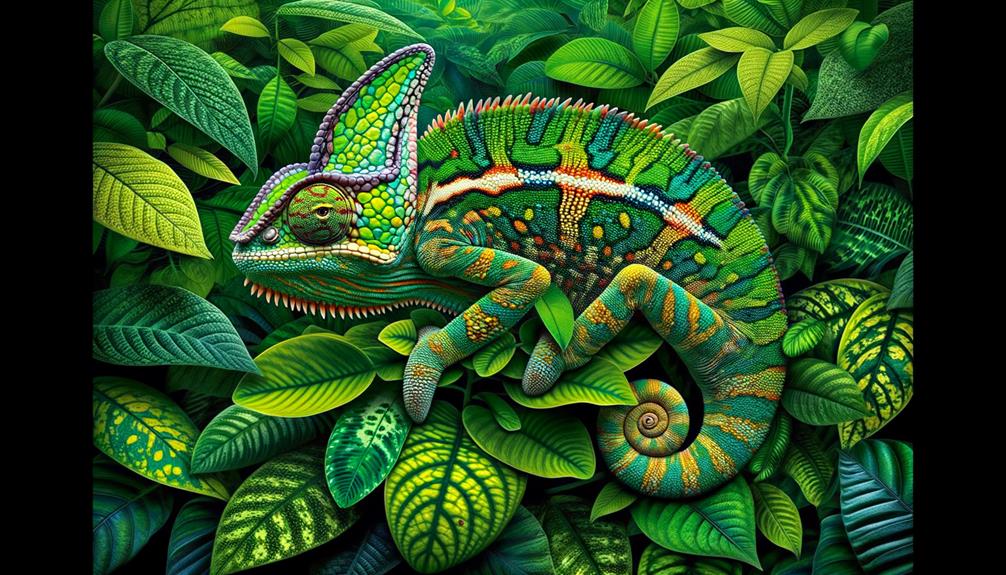I've always been drawn to the dazzling iridescence of reptile scales, created by the intricate dance of light and nanostructured layers. These scales, composed of melanin and keratin, act like tiny prisms, scattering light to produce vivid, shifting hues. Take, for instance, the color-shifting Panther Chameleons or the shimmering Rainbow Geckos – each a living masterpiece of natural engineering. This iridescence not only dazzles but also offers survival benefits like camouflage and mate attraction. The intricate details of these nanostructures are a marvel of evolution, inspiring cutting-edge innovations in biomimetic materials. If you're curious, there's more to explore.
Key Takeaways
Iridescent reptile scales create a mesmerizing display of shifting hues through the interaction of light with nanostructured layers of melanin and keratin.
The microscopic ridges and grooves on the scales scatter and reflect light, producing dynamic color displays. This remarkable feature is seen in species like Panther Chameleons and Rainbow Geckos, which use their vivid, color-shifting scales for camouflage and social signaling.
The unique nanostructures in these scales have inspired advances in biomimetic materials and photonic devices. Beyond their visual appeal, iridescent scales serve multiple functions, including camouflage, mate attraction, and thermal regulation.
By studying these remarkable structures, scientists can develop new materials and technologies that manipulate light in innovative ways, opening up new possibilities for a range of applications.
Science of Iridescence
The science of iridescence in reptile scales is fascinating because it involves the intricate interplay of light and nanostructured layers, resulting in mesmerizing colors. At the core of this phenomenon is the way light reflects off the layered structures within the scales. These layers, primarily composed of melanin and keratin, are meticulously arranged to create optical interference, producing vivid, shifting hues.
What's truly captivating is how the intensity and hue of iridescence change depending on the angle of illumination and observation. When light hits these multilayered scales, it reflects and refracts, interacting with the nanostructure to display a spectrum of colors. This dynamic display serves essential functions, like communication, camouflage, and thermoregulation, tailored to each species' environment.
Studying these natural wonders has led to breakthroughs in biomimetic materials. By replicating the structural principles of reptile scales, scientists are developing innovative applications in optics, sensors, and energy-efficient coatings. This blend of natural beauty and scientific ingenuity continues to inspire and challenge our understanding of light manipulation and material science.
Types of Iridescent Reptiles
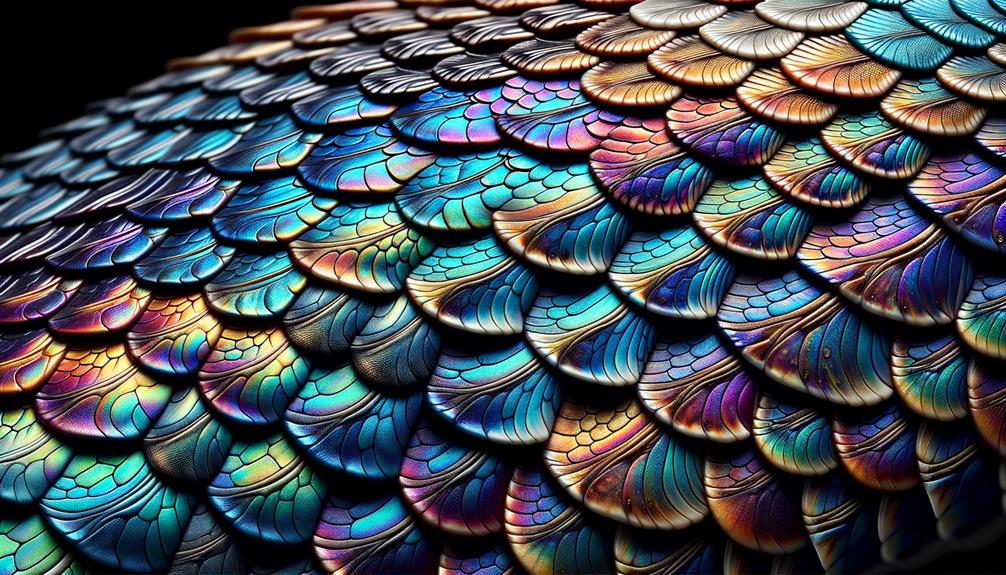
Examining the diverse range of iridescent reptiles reveals a stunning array of colors and effects. Take, for instance, the color-shifting chameleons of Madagascar, which can display vibrant greens and blues. The Panther Chameleon, in particular, is a master of disguise, changing its colors to blend in with its surroundings. This remarkable ability is made possible by microscopic structures within its skin.
Geckos, too, showcase their own brand of iridescence. The Rainbow Gecko, with its dazzling display of shimmering hues, is a prime example. The source of these colors lies in the multilayer interference of light waves reflecting and refracting off the gecko's scales.
Snakes, like the reticulated python, also boast striking iridescent scales. Native to Southeast Asia, these pythons flaunt golden, iridescent scales that glint in the light, giving them an otherworldly appearance. This effect is produced by the unique arrangement of microscopic structures on their scales.
Some notable iridescent reptiles include:
| Reptile | Region | Key Feature |
|---|---|---|
| Panther Chameleon | Madagascar | Color-shifting greens/blues |
| Rainbow Gecko | Various regions | Shimmering multicolor hues |
| Reticulated Python | Southeast Asia | Gleaming golden scales |
These creatures are a testament to nature's boundless creativity and the incredible diversity of the natural world.
Evolutionary Advantages
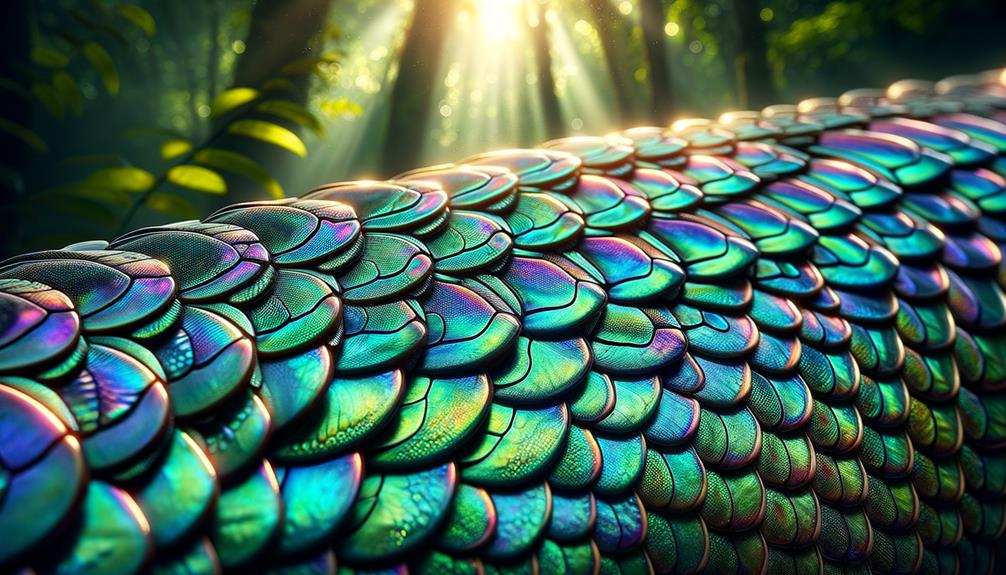
By harnessing the intricate optical properties of their scales, iridescent reptiles acquire significant survival and communication benefits. These shimmering surfaces do more than just dazzle our eyes; they play vital roles in the natural world.
- Camouflage and Predation Evasion: Reptile scales can change color depending on the viewing angle, allowing them to blend seamlessly into their surroundings. This ability confuses predators, making it difficult to focus on the reptile as it moves, which reduces the likelihood of being caught.
- Mate Attraction and Social Signaling: The vivid colors produced by the microscopic ridges and grooves on their scales serve as signals during mating rituals. Bright, iridescent scales can indicate a healthy and genetically superior mate, which enhances reproductive success.
- Territorial and Threat Displays: Reptiles often use their iridescent scales to assert dominance or warn off potential threats. A sudden flash of bright, shifting colors can startle and deter rivals or predators, providing a vital advantage in survival.
These benefits highlight how the mesmerizing beauty of iridescent scales is intertwined with the practical demands of reptilian life, illustrating nature's brilliance in adapting form and function.
Role of Nanostructures
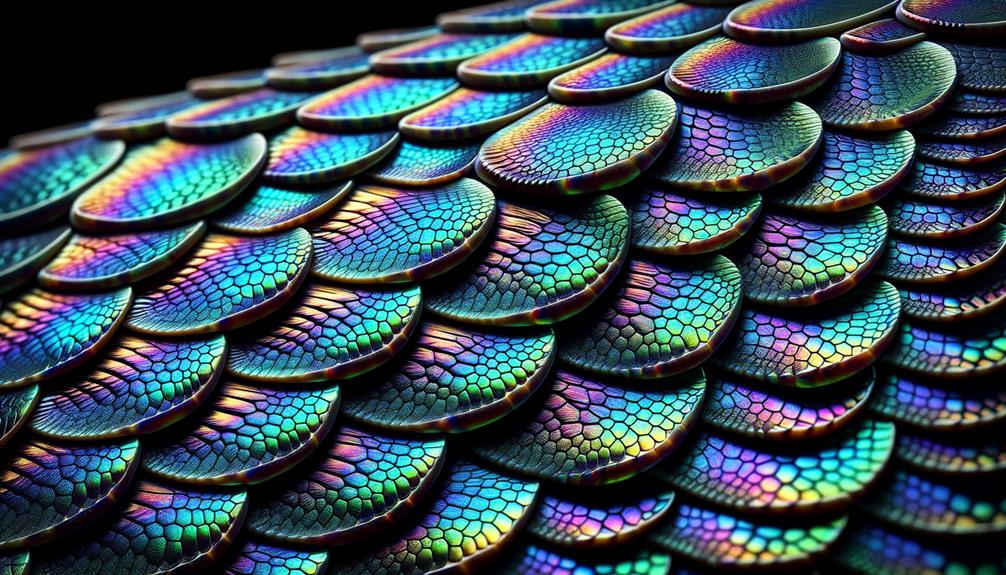
The intricate patterns on reptile scales have a mesmerizing effect on us, thanks to their unique ability to manipulate light and create stunning iridescence. These tiny features, including grooves, protrusions, and ridges, are arranged in hierarchical patterns that allow for selective reflection and interference of light, resulting in vibrant color effects.
What's fascinating is how subtle variations in the size, spacing, and orientation of these nanostructures can give rise to a diverse array of iridescent patterns across different reptile species. These variations aren't random; they're the result of evolutionary adaptations designed to interact with light in specific ways. When light hits these scales, it bounces around within the nanostructures and emerges in different colors depending on the angle of view and the light's wavelength.
Scientists are drawn to these natural wonders because they have inspired the development of biomimetic materials. By studying these nanostructures, researchers can create materials with similar optical properties for use in displays and camouflage. By understanding how these light interactions work, we can design advanced photonic and optoelectronic devices. This fusion of nature and technology holds immense potential for innovation.
Spectacular Color Displays
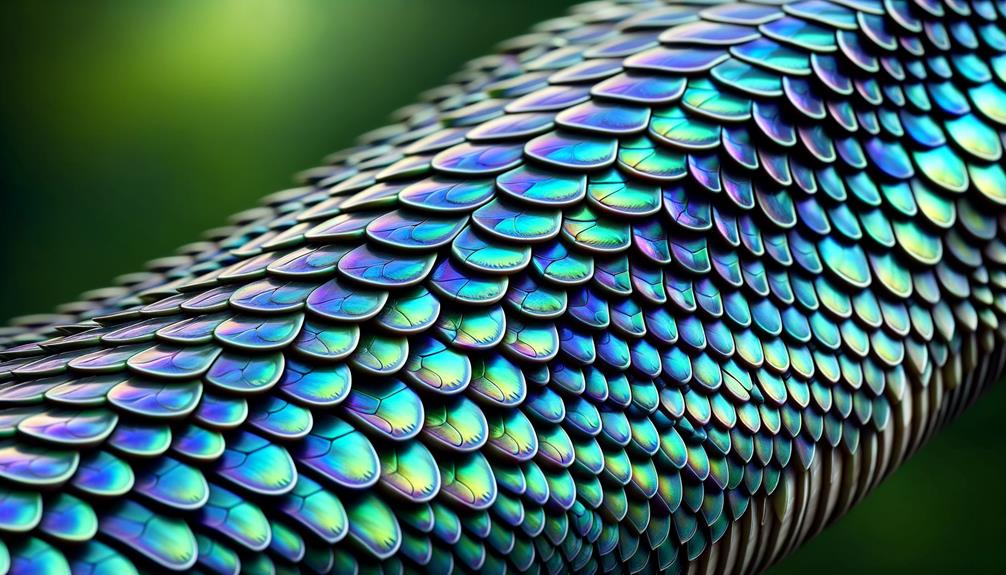
The dazzling iridescent color displays seen in many reptiles are a direct result of the complex microstructures embedded within their scales. These intricate features create optical effects that shift dramatically based on lighting conditions and viewing angles. What fascinates me is not just their beauty, but the science behind it. The scales' specialized surfaces, with multilayer interference structures, play a pivotal role in these spectacular color displays.
To illustrate this, consider the following:
- Chromatic Shifts: When light hits a snake's scales, the color can shift from a deep blue to a vibrant green, depending on the angle.
- Camouflage: Some lizards use their iridescence to blend seamlessly into their surroundings, reflecting the colors of their environment to stay hidden.
- Thermal Regulation: The reflective properties of these scales can help regulate body temperature, reflecting harmful UV rays and reducing heat absorption.
Studying these mechanisms has led to breakthroughs in biomimetic materials and coatings. The iridescence serves multiple purposes, from signaling to potential mates to evading predators. Every time light hits these scales, it's a mesmerizing display of physics and biology, showcasing nature's incredible adaptability.
Observing Iridescent Scales
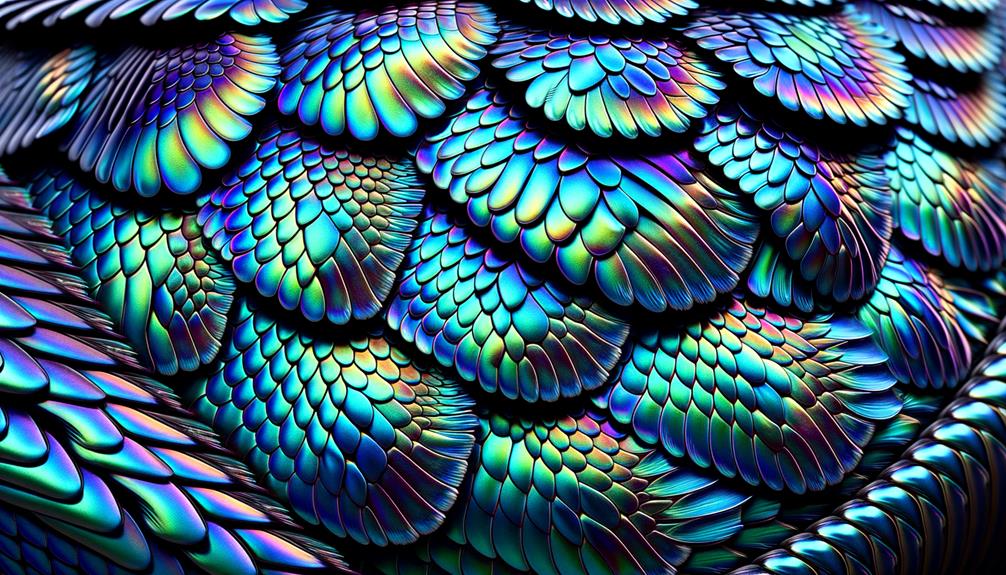
When I observe the iridescent scales of reptiles, I'm fascinated by the way light reflection mechanisms create such vibrant colors that shift with the angle of view. The intricate interplay between nanostructures and light not only produces these stunning visual effects but also reveals the remarkable adaptations these creatures have developed over time. By studying these mechanisms, we can gain a deeper understanding of the factors behind color variation and uncover new opportunities for innovative applications in material science.
Light Reflection Mechanisms
Observing the iridescent scales of reptiles reveals a fascinating interplay of light and microscopic structures, where each ridge and groove meticulously orchestrates a symphony of colors through selective light reflection. When light hits these scales, it encounters a complex architecture that manipulates its path, creating the vibrant, shifting hues we see.
Several key factors contribute to this mesmerizing effect:
- Hierarchical Scale Arrangement: The scales are arranged in a way that enhances light interference. Each scale's surface features tiny ridges and grooves, which scatter and reflect light at various angles, producing a dynamic array of colors.
- Refractive Index Variations: The different layers within the scales have varying refractive indices. This difference causes light to bend and separate into its constituent wavelengths, resulting in the observed iridescence.
- Angle of Incident Light: The angle at which light strikes the scales profoundly influences the colors that appear. A slight change in perspective can shift the visible colors, adding to the scales' dynamic beauty.
These mechanisms aren't just visually stunning; they inspire innovative designs in photonic structures and advanced optical devices. By mimicking these natural processes, we can create materials that replicate the striking iridescence of reptile scales, opening up a world of aesthetic and functional possibilities.
Color Variation Factors
Iridescent reptile scales showcase a dazzling array of colors, and several factors contribute to this visual spectacle. The microscopic structure of the scales plays a crucial role, with layers of keratin and guanine crystals creating a diffraction grating that splits light into its component colors. As the angle of light changes, so does the color seen by the observer.
The thickness and spacing of these microscopic layers can vary greatly between species and even between individuals, resulting in a wide range of color effects. Some reptiles display more blues and greens, while others shimmer with reds and golds. This variation is influenced not only by species but also by the reptile's diet and environment.
The presence of pigments like melanin can interact with the structural coloration to produce even more complex visual effects. For instance, a dark pigment underlying an iridescent layer can heighten the intensity and contrast of the colors. Observing these dazzling scales under different lighting conditions reveals the dynamic relationship between structure and pigment, making each encounter with an iridescent reptile a unique experience.
Frequently Asked Questions
What Snake Has Iridescent Scales?
Imagine a living rainbow slithering through the jungle – it's the reticulated python. Its scales shimmer and change color under different lights, thanks to its unique genetic makeup. This natural marvel could inspire future optical and photonic innovations, offering a wealth of possibilities for scientists and researchers.
Why Are Sunbeam Snakes Iridescent?
Sunbeam snakes have an iridescent sheen because their scales are made up of layers of keratin and pigments that reflect and refract light. This unique coloration helps them blend seamlessly into their surroundings, making it easier for them to avoid predators and sneak up on prey.
What Is the Reptile Scale Anatomy?
Reptile scale anatomy fascinates me. Each scale, made of keratin, overlaps to provide protection and flexibility. The surface microstructures of these scales vary, influencing functions like movement, water repellency, and temperature control. It's a perfect balance of form and function.
Does a Snake Have Scales?
Imagine walking barefoot on scorching desert sand – you'd need some serious protection, right? Snakes have got that covered with their scales, which act like built-in armor. Made from keratin, these scales not only shield them but also help them move efficiently by providing the right amount of grip. The ventral scales, in particular, are specialized to get the job done.



